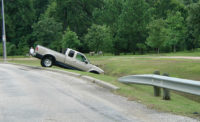From Safety 2015
Understanding and influencing risk tolerance
Why did the worker do that?

Determining why a worker decides to accept risk goes to the heart of behavior-based safety.
Dave Fennell, CRSP of ExxonMobil said the brain’s risk assessment process works in three ways; Exposure (hazard recognition), Perception (knowing what impact a risk might have) and Decision (accepting, mitigating or rejection the risk). Fennel and Mike Williamsen, Ph.D., CSP, of Caterpillar Safety Services conducted a joint presentation at Safety 2015 designed to help safety professionals understand and influence how employees assess and respond to risks.
Two out of three
While many companies conduct a great deal of training about hazard recognition and risk perception, not as much attention is given to the decision-making process.
Fennel and Williamsen identified ten influencing factors in risk tolerance:
- Overestimating capability/experience
- Familiarity with the task – especially among senior workers.
- Seriousness of the outcome – something that can be diminished by the terminology used. Williamsen cited, as examples, the oil and gas industry term “sweet gas,” which refers to the dangerous hydrogen sulfide and the phrase, “pinch point,” which actually could be designating an amputation hazard.
- Voluntary actions and being in control – which comes into play a great deal outside of work. Williamsen said a survey of Caterpillar’s industrial employees found that 90 percent of their injuries occurred off the job (although those injuries often affected the worker’s ability to do the job).
- Personal experience with a serious outcome. “As your organization gets safer and safer, you’re going to get fewer and fewer people who’ve had a personal experience with a serious outcome,” said Fennell. “The new people won’t understand it. They don’t remember it.” He said that senior workers can be helpful in communicating about serious incidents to newer workers.
- Cost of non-compliance, or, how is this going to affect me?
- Confidence in the equipment – which can actually be overconfidence..
- Confidence in protection and rescue. Williamsen said some oil and gas companies found that after they handed out the “blue suit” – Nomex apparel, which doesn’t burn – the incidence of burn injuries increased, because what’s underneath the suit burns. Impact resistant gloves and gas detectors that can only detect certain gases may also lead to an overly optimistic reliance on them.
- Potential profit and gain from action. “When we can gain, we accept more risk,” said Fennell. An example: longer working hours that yield bigger paychecks but can cause fatigue-related risks. He encouraged safety professionals to go back to their workplaces and evaluate practices that may be creating incentives to accept more risk.
- Role models accepting risk. Because of personality or experience, leaders in a group or organization can have a powerful effect on those around them.
How to influence risk tolerance
The move to action given by Fennell and Williamsen involves giving workers a tool, a process, in effect, that forces them to ask:
- What could go wrong?
- How bad could it be?
- What could I do about this?
“Give your workers a tool and teach them how to use it on and off the job,” said Fennell. “Have conversations with your workers about tolerance. Don’t just show a video or a power point presentation. Commit to changing the culture in your company.”
He likened risk tolerance to an addiction. “We need to admit we have a corporate problem and a personal problem before we can do something about it.”
He and Williamsen suggested using a prompt, like a card they distribute to workers entitled, “I Choose to Reduce Risk.” On the card, the worker is asked to identify the risk and determine what they will do in order to reduce it.
Looking for a reprint of this article?
From high-res PDFs to custom plaques, order your copy today!






